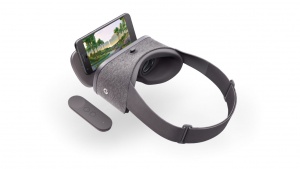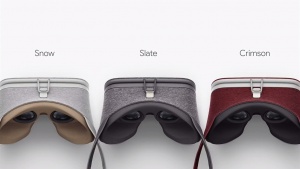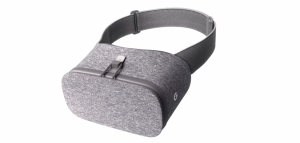Daydream View
| Daydream View | |
|---|---|
| Basic Info | |
| VR/AR | Virtual Reality |
| Type | Head-mounted display |
| Subtype | Slide-on HMD |
| Platform | Daydream |
| Developer | |
| Release Date | November 10, 2016 |
| Price | $79 |
| Website | Daydream View Website |
| Requires | Daydream Ready Phones |
| Predecessor | Google Cardbord |
| System | |
| Operating System | Android |
| Storage | |
| Display | |
| Display | 5 / 5.5 inch AMOLED (Pixel / Pixel XL) |
| Resolution | 1920 x 1080 / 2560 x 1440 (Pixel / Pixel XL) |
| Refresh Rate | 60 Hz |
| Persistence | 5.1ms (Pixel), 3.1ms (Moto Z), 3.3ms (Huawei Mate 9 Pro) |
| Image | |
| Field of View | 90° (nominal) |
| Optics | |
| Tracking | |
| Tracking | 3DOF |
| Rotational Tracking | Accelerator, Gyrometer, Proximity |
| Positional Tracking | None |
| Update Rate | Rotational: 1000 Hz, high accuracy |
| Latency | Motion to Photon: <6 ms (Pixel), <6ms (Mate 9 Pro), <10ms (MotoZ) |
| Audio | |
| Audio | None? |
| Camera | ?? |
| Connectivity | |
| Device | |
| Weight | ??? |
| Input | Daydream Controller |
| Size | 202 x 116 x 93mm |
- "<10ms (MotoZ)" cannot be used as a page name in this wiki.
- "<6ms (Mate 9 Pro)" cannot be used as a page name in this wiki.
- "Motion to Photon: <6 ms (Pixel)" cannot be used as a page name in this wiki.
Introduction
Daydream is a Virtual Reality head-mounted display developed by Google for Daydream Platform. To use Daydream View, users need to mount a Daydream ready Smartphone inside it. The smartphone serves not only as View's screen but also as its processor and tracking device. For input, Daydream View has a small, remote-like controller with rotational tracking (3DOF) built-in. Neither the HMD nor the controller possess positional tracking.
Announced on October 4, 2016, Daydream View was released in November 10, 2016 for $79. Users who pre-order Pixel or Pixel XL will receive the HMD for free.
Contents
Daydream Ready Phones
- Pixel - Released on October 20, 2016 for $649
- Pixel XL - Released on October 20, 2016 for $769
Motorola
- Moto Z - Released on June, 2016 for $400
Huawei
ZTE
Samsung
LG
Asus
Hardware
Design of HMD
Daydream View consists of a plastic body wrapped in soft and cushy fabric. The HMD fits over most eyeglasses and the outer fabric is removable and washable. The overall feel of the HMD is simple and light without being cheap. It comes in 3 colors: slate, snow and crimson.
Daydream View has lenses and a NFC tag concealed within the front cover, unlike the Gear VR, which also has IMUs, fans, and a microUSB port. The Daydream View HMD does not need to be connected to the phone: the NFC tag detects the phone when it is in place. View not only relies on the phone for processing but also for tracking (3DOF).
The front cover of the HMD is mostly open. It relies on a spring-loaded hinge below, an elastic hook above and few high-friction pads to keep the phone in place. This method allows the HMD to be compatible with phones of various sizes and thicknesses. Additionally, there are 2 black capacity pads that touch the phone's screen. The HMD detects when the phone is in place and these pads adjust the screen to the correct position.
Unlike many other HMDs, Daydream View does not have a top strap. It has 1 strap that goes horizontally across your head. It does not use velcro, instead the HMD uses plastic loops to adjust, tighten and loosen the straps.
Problems
Light leak and lens glare are two of the problems with the Daydream View. Because the HMD is designed to accommodate phones of various sizes, light from external environment can enter the HMD from the side of lenses. In scenes of high contrast such as white objects on a black background, you'll see thin layer of light around the edges of your view.
With Pixel
The screen door effect is less noticeable on View than on Rift or Vive. Black smear, dark areas of the screen that smear across light areas during head movement, occurs due to OLED’s inability to change true black pixel colors very rapidly.
The Controller
The Daydream Controller is a small, remote-like device with rotational tracking (3DOF). It allows the user to intuitively point at objects in VR with a mouse cursor. In addition to 3DOF tracking, the controller has a trackpad and 2 round buttons on top and 2 volume buttons on the sides. The controller is wireless and is recharged through a USB-C cable.
Specifications
Head-Mounted Display
| Part | Spec |
|---|---|
| Field of View | 90° (nominal), varies by phone |
| Dimensions | 202 x 116 x 93mm |
| Weight | ??g |
| Sensors | Accelerator, Gyrometer, Proximity |
| Tracking | 3 degrees of freedom (rotational) |
| Update Rate | Rotational Tracking: 1000 Hz, high accuracy |
| Latency | Motion to Photon: <6 ms (Pixel), <6ms (Mate 9 Pro), <10ms (MotoZ) |
| Input | Daydream Controller |
| Audio | None? |
Smartphones
Google Pixel / Pixel XL
| Part | Spec |
|---|---|
| Display size | 5 / 5.5 inch AMOLED |
| Resolution | 1920 x 1080 / 2560×1440 |
| Pixel density | |
| Refresh rate | 60 Hz Low-persistence |
| RAM | 4GB |
| Storage | 32 or 128 GB |
| Battery | 2770 mAh / 3450 mAh Non-removable |
| Weight | 143g / 168g |
| OS | Android 7.1 and up |
Requirements
- MUST have at least 2 physical cores.
- MUST support sustained performance mode.
- MUST support Vulkan Hardware Level 0 and SHOULD support Vulkan Hardware Level 1.
- MUST support H.264 decoding at least 3840 x 2160 @ 30fps-40Mbps.
- MUST support HEVC and VP9, MUST be capable to decode at least 1920 x 1080 @ 30 fps-10Mbps and SHOULD be capable to decode 3840 x 2160 @ 30fps-20Mbps (equivalent to 4 instances of 1920 x 1080 @ 30fps-5Mbps).
- STRONGLY RECOMMENDED to support android.hardware.sensor.hifi_sensors feature and MUST meet the gyroscope, accelerometer, and magnetometer related requirements for android.hardware.hifi_sensors
- MUST have an embedded screen, and its resolution MUST be at least be Full HD (1080p) and STRONGLY RECOMMENDED to be Quad HD (1440p) or higher
- MUST measure between 4.7″ and 6″ diagonal
- MUST update at least 60 Hz while in VR Mode
- The display latency on Gray-to-Gray, White-to-Black, and Black-to-White switching time MUST be ≤ 3 ms
- The display MUST support a low-persistence mode with ≤5 ms persistence
- Device implementations MUST support Bluetooth 4.2 and Bluetooth LE Data Length Extension.[1]
Setup Tutorial
Setting up the HMD is very easy.
- Open the HMD's front cover and remove the included controller.
- Turn your phone on and put it inside the front cover.
- Close the cover and place the HMD on your head.
- Adjust the HMD until the images are clear.
- Adjust the straps.
- Calibrate the controller.
Apps
Daydream Home
Other Apps
- Gunjack 2
- Netflix
- HBO
- Hulu
- Star Chart
- Google Movies
- Google Photos
- Google Street View
- YouTube VR
- Fotonica
- Land’s End
- Minecraft: Pocket Edition
- Lara Croft Go
- Talking and Nobody Explodes
- Smash Hit
- The Room
- Google Arts and Culture
- Wonderglade
- Mekorama
- Star Chart VR
- Hunter's Gate
- Wall Street Journal
Images
History
November 10, 2016 - Daydream View is released.
October 4, 2016 - Daydream View is announced.
May 18, 2016 - Daydream Platform is announced at Google I/O 2016.


